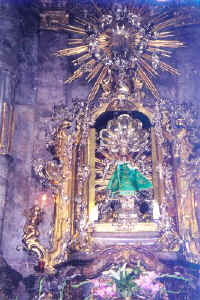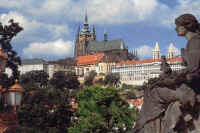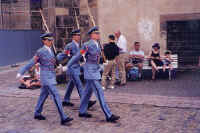|
Prague
Saturday, 25 July: Having the morning free, we slept until 8:00, then had a leisurely breakfast. At 10:00 we
took the subway and a streetcar to the Lesser Quarter. We rode the funicular to the top only to find that the
view was much better one stop below. The view of Charles Bridge and Old Town was spectacular.
After riding back to the bottom, we walked a couple of blocks to the Church of Our Lady Victorious (early 17th century), home of the Infant of Prague statue that our little church (Holy Infant) back in Elkton, Virginia, is named for. The statue was brought to Prague from Spain in 1628 by a Spanish noblewomen who married a Czech king. It is displayed in a golden altar, always dressed in one of its 73 rich robes. The statue was much smaller than we expected (only 20"). From the church we walked the short distance to the west end of the Charles Bridge. I climbed to the top of the tower for a great view of the bridge and Old Town Beyond. Then I joined Jane on the bridge. We spotted on old water wheel in a narrow stream separating a small island from the west bank of the river.
From there we walked up a steep, narrow street to the Prague Castle. We took another look at St.
Vitus Cathedral, then went inside the old Royal Palace. Foremost among the many rooms was Vladislav Hall
(15th century), the largest hall in medieval Prague, where the coronation of kings took
place.
We exited the palace in the square in front of the Basilica of St. George. By luck, the guard was changing just as we emerged. Then we went into the old basilica. Although always described as dating to the 10th century, the original church was destroyed by fire and rebuilt in 1142. Showing its early origins, the interior was far simpler than in most churches, but it was beautiful in its simplicity. We also took a quick look into the adjoining convent. It was much larger, and far lovelier, than it appeared from the outside, with a cloister to rival that of any monastery. From Castle Hill we walked back to the hotel and got back just before 3:00. Jane had scheduled a 45-minute massage in the hotel's spa (cost: $20). I still wanted to learn about the Loreto, so I took off again. I found a way to combine the subway and a streetcar and get to the high point of Castle Hill with almost no walking. I walked down to the Loreto and entered the courtyard. I learned that there are numerous Loretos throughout the world. According to legend, the house in Nazareth where Mary was born, and later lived with the Holy Family after their return from Egypt, was moved by angels to Italy, to a hill called Loreto, in 1295. Replicas of the Santa Casa (bearing no particular physical resemblance to the original) are named for this site in Italy. The Loreto of Prague, when it was built in 1626, was a simple brick building, compatible with the legend. The inside remains much the same, but the exterior was later covered with elaborate stucco work depicting in relief various scenes relating to Mary. The buildings surrounding the courtyard where the Santa Casa is located contain five separate chapels and the main Church of the Nativity. The second floor houses the Treasury where precious gifts (mostly chalices, monstrances, and similar items) presented to Our Lady of Loreto are displayed. Finally sufficiently informed about the meaning of "Loreto," I headed back to the hotel, arriving about 4:30. Katie took us by bus at 5:30 for our dinner at the elegant Poet Restaurant in Prague Castle. We were caught in a brief shower as we got off the bus, the only serious rain we felt on the entire trip. The food was excellent, and the rain was long gone when we emerged at 7:15. Katie then took us to the Villa Bertramka for a play entitled "A Night with Mozart." Mozart lived in this villa during his two stays in Prague (1787 and 1791), and it was here that he composed the opera Don Giovanni. While waiting for the performance, we went through the museum housed in the villa. It was mostly period furniture and furnishings, but there were interesting pictures and a couple original scores written by Mozart. Back in the garden, we were invited into the music room by the actress/soprano playing Josefina Duskova, rumored to have been Mozart's mistress during his visits. The room was only about 30' by 30', making for a very intimate setting. The evening's program was not strictly a musical performance, although there was plenty of music. It was a reenactment of an evening Mozart spent at the villa in 1787, and was based on a contemporary written account by Josefina. According to her, Mozart wrote Don Giovanni that evening in just a few hours, after Josefina locked him in a room and refused to let him out until he finished it. (One suspects that he already had written most of it well before then.) All the dialog was in German but, with the aid of a summary in English, it was not hard to follow. The music, and especially the singing, was outstanding. After the performance, the bus took us directly back to our hotel. We got there about 10:00 p.m.
Copyright © 2000-2023 DarrellPeck.com All rights
reserved. | |||||||

















